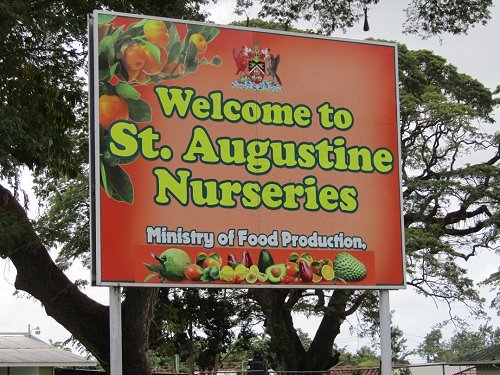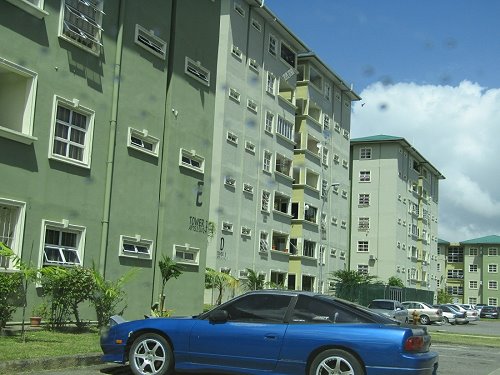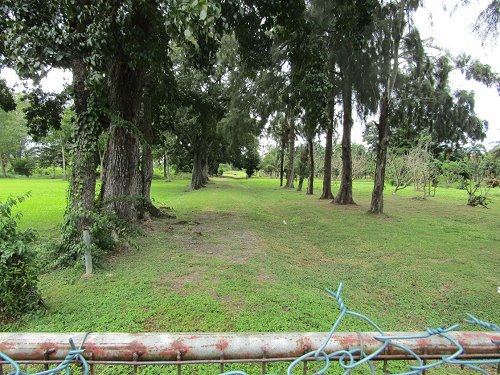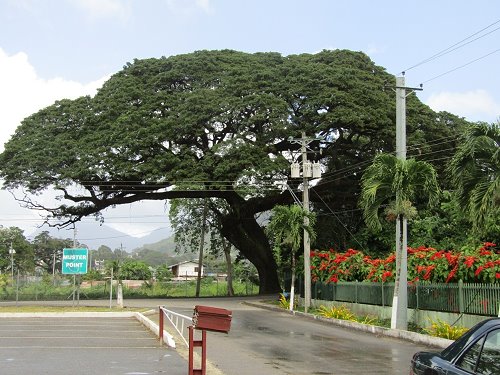By Stephen Kangal
February 15, 2018
 The news of the proposed surreptitious plan hatched by the HDC to further desecrate and destroy the peaceful ambience, luxuriant foliage and agricultural input of the St Augustine Nursery to establish another voter-padding housing settlement in the St Joseph constituency must be resisted by all environmentalists and the residents of Curepe-St Joseph with full civic society force.
The news of the proposed surreptitious plan hatched by the HDC to further desecrate and destroy the peaceful ambience, luxuriant foliage and agricultural input of the St Augustine Nursery to establish another voter-padding housing settlement in the St Joseph constituency must be resisted by all environmentalists and the residents of Curepe-St Joseph with full civic society force.

Since the 1950’s voter-padding housing has been creeping on the sanctity of this veritable green sanctuary with the latest being the East Grove (Ramgoolie Development) making the St Joseph seat no longer marginal based on the 2015 election results.

Now it is the North Grove housing concoction about to chip away at this pristine piece of nature’s paradise to make way for high -rise concrete and steel to compromise the innocence of the landscape occupying lands west of the Southern Main Road, Curepe.
We call this progress PNM-style.
The desecration and rape of the ultra-fertile soils of the St Augustine Nursery to build voter padding HDC houses by this Administration is nothing short of callousness, insensitivity, rapaciousness, savagery and barbaric to the max. These sandy-loam lands are heavenly. They have been fertilized and enriched by layers of alluvial deposits from the St Joseph River for centuries. It yields abundantly.
In this veritable Garden of Curepe we obtained all our high quality, disease- resistant fruits, vegetables and foliage planting materials for decades and we fed ourselves.
The site is idyllic, green, serene with an array of trees planted by the colonial government. It is a miscarriage of poetic, civic and political justice to interfere with what nature has conferred on our landed patrimony for centuries long.

Nothing short of the orchestration of militant demonstrations along Southern Main Road leading into Farm Road must be mounted by all environmentalists to stop this rape of our landed patrimony by political eunuchs. This sanctuary must be rescued from the hands of raiders and pillagers who want to rob the people of Curepe of this oasis in this desert of political opportunists and vagabonds.
They must be stopped at all costs because they got away with the Ramgoolie desecration. They now feel encouraged to further misappropriate the environmental and agricultural legacy of Curepe/ North Trinidad to foster and promote their own nefarious political agenda using the untouchable hanging Gardens of Curepe to conduct their dirty work.


You should let us know if that “voter-padding housing settlement” was for PNM’s supporters alone and if Indians, who were aligned with another political party, applied for units and were denied. How many Indians would apply to live in housing schemes among Africans?
Over the years the HDC has been insensitive to catering for the cultural needs of the Indian community by offering houses that meet their requirements. Indians do everything at home including funerals, weddings, week-long prayers etc. Houses must cater for this norm. Look at La Paille Gardens and Ibis Gardens that have a mixture of prepared lots and built units on one lot of land ans look at the mixture achieved there once houses are culturally sensitive and responsive in a multicultural society such as ours. But the point here is the use of environmentally sensitive and exceedingly productive land in a very natural and beautiful environment producing seedlings for over a 100 years and destroying their further production thus adversely reducing the availability of seedlings for commercial and domestic agriculture and the landscaping industry. In a First world country this could not happen at all. The HDC is confiscating 20 acres of a parcel of 60 acres that is the area of the St Augustine Nurseries and in this 20 acres there is all the plants and trees from which cuttings are harvested to generate the seedlings for mango, citrus, ornamental plants, avocadoes, sour sop and a host of planting materials. South of the Caroni Bridge just north of the Industrial Park there are excellent lands for housing without affecting other more important uses with water, lights, excellent roads and not confined spaces just opposite the La Paille Gardens Housing Development. As a growing industrial society we have to preserve our green spaces especially at SMR Curepe where there are no parks for recreation but several WASA wells located right in the Nurseries producing millions of gallons of potable water for nearby residential areas and this will be lost forever because of the contamination of the aquifers from high density housing effluents and waste water. I visited the Nurseries three times since Sunday last including today and saw the vast array of trees/plants etc that will be cut down and bulldozed and these cannot be replaced quickly to support the production of the planting materials by the Nurseries to support agricultural production including our fruit production. Check my Facebook page for all the photographic evidence militating against this madness in Curepe being incubated at present.
While your concerns about the use of the land is valid, I want to address aspects of your commentary that deserve another perspective.
“Over the years the HDC has been insensitive to catering for the cultural needs of the Indian community by offering houses that meet their requirements. Indians do everything at home including funerals, weddings, week=long prayers etc. Houses must cater for this norm.“
This is government housing; is it that the government should cater to all the wants of the Indian community?
Anyway, do you believe that Africans do not want to do things at home … have weddings, gardens, extended families etc.?
The fact that this never stopped being a norm for Indians speaks to a bigger picture; it tells a story of historical inequality. During the period of colonialism, Indians during indentureship were allowed to retain cultural practices. This was not so for enslaved Africans who went through a ‘seasoning’ period which attempted to strip them of their culture and identity.
Furthermore, post-emancipation Africans did not receive land or any form of compensation and were forced into living conditions that did not allow for such practices to evolve. The colonial government made it near impossible for Africans to purchase land in the post-emancipation period and deliberately destroyed the peasantry. Historically, Africans had very similar elaborate practices regarding weddings, family gatherings, funeral ceremonies and rites of passages that required lots of housing space. These were first discouraged and aspects of it made illegal in their attempts to break the spirit of Africans.
Some Indians received land after indentureship and some used the money paid to them to purchase land. On these lands, Indians were able to retain cultural practices which today can be considered norms. Given this historical inequality, the responsibility of any government should be redressing these historical wrongs and inequities.
None of these housing schemes were adequate for Africans. Inadequate spaces and facilities contributed to some of these neighborhoods descending into crime-ridden communities, but Africans accepted them because they were desperate. All governments have failed in this regard.
While many Indians may have been desperate as well, many resided on communal lands.
Historically, Indians never wanted to mix with Africans, so I do not believe many Indians were applying for government housing. Some may feel more emboldened to do so today in new housing schemes that appear to be upscale. They may have been encouraged to do so during the UNC’s term in office.
During the period of colonialism, Indians during indentureship were allowed to retain cultural practices…
This is a myth that has been repeated ad nauseam by Africans. The fundamental essence of the Indian character is cultural persistence that has been universally acknowledged. The anglo-whites could have have favoured the Indians because they had no answer to the cultural persistence of the Indians. The Indians regarded themselves as culturally superior to the massas. If any body tried to deculturalise the Indians it was the PNM regime of 1956 and after but without any success by their policy of non-recognition, marginalisation and rural neglect.
But Williams in his 1962 address said that Mother T&T cannot discriminate amongst her children and the Constitution and the Law have embedded in its reach equality of treatment.
Yes the State must respond adequately and sufficiently to diversity in T&T. That is equality of treatment. I Spoke of La Paille Gardens and Ibis Gardens and you can add Sanavannah Heights in Charlieville where state housing responded positively to the cultural and social aspirations and needs of the Indians and a desirable ethnic balance has been successfully achieved.
Africans must give up the excuses of victimnhood as well as the other myth that the colonials stripped their ancestors of their cultural moorings during slavery. They readily were assimilated into massa’s domain and even took the names of the French and English planters. In return they ridiculed the names of the Indians as well as their food and culture even up to today.
Indians did not live on communal lands. They bought or were allocated lands in lieu of their return passage after 5 years of indentureship and lived in the rural fringe cultivating Dharti Mata’s lands. They were not the squatting type.
You will recall that Africans gravitated to the towns and cities post-emancipation where they sought service-oriented employment because agriculture was not their forte. This is why the Indians arrived in 1845 and lived in the barracks deserted by the Africans is search of a better life in the towns and POS.
This explains why the current distribution of populations is what it is today except that re-settlement is taking place as well as decentralisation of housing that relieves the pressures of increasing density of population in the East-West Corridor that creates a range of social problems and indeed ghettos of crime and drug dealing in a mushrooming gang culture that must be reduced to save the black youths from premature demise.
Housing must be decentralised including a serious study on the use of alpine sites to establish public and private housing settlements where agriculture is not possible.
I repeat that once public housing is equitably designed and located Indians will avail themselves especially the young newly married couples who face the same exorbitant prices and enjoy the largesse of mobility that reduces the need to live in cloistered settlements. This is a national imperative that must be adhered to.
But the point is that building houses in a nursery of 100 years old with enormous natural wealth and beauty is indeed s desecration of an unmatched heritage site that must be preserved for posterity ti insulate them from the ravages of industrialisation and urbansisation in a future-centred planning mode.
SOUND_ Save Our Nursery From Destruction-SOUND
Before Africans join anyone in protest we should make sure that we are not aligning ourselves with people and their agendas that are inherently anti-African. Case in point is Kangal’s reply.
Kangal said: During the period of colonialism, Indians during indentureship were allowed to retain cultural practices… This is a myth that has been repeated ad nauseam by Africans.
Were laws passed or attempts made to ban Indian cultural practices? Indians were never seen as a threat to White rule in the colonies as most of the colonisers quickly learnt. As a matter of fact, they encouraged Brahmin pundits to these shores as a means of solidifying control over Indentured Indians. There is actual history to support this. Whites favoured Indians because they were willing to work for less money and their caste system favoured white rule, especially in the colonies.
Kangal said: The Indians regarded themselves as culturally superior to the massas.
It is true that Indians view themselves, not only as culturally superior but, racially superior to Africans in general. Of course, this idea lacks any historical or scientific validity. The reality is that what passes for Indian culture, minus the racism annexed to the caste system, was part of Black traditions in India which have their roots in Africa. Anyone who is versed in African history can find these links. Even Sanskrit has some of its roots in Africa as Dr. Clyde Winters explains:
“According to Arthur A. Macdonell in A Sanskrit Grammar for Students (1997), says that the Sanskrit language is known by many names. It was called Nagari ‘urban writin’, Deva-nagari ‘city writing of the gods’. V. Kanakasabhai in the Tamils Eighteen Hundred Years Ago, says that Sanaskrit is called Deva-nagari, because it was introduced to the Aryas by the Nagas. The characters associated with Deva-nagari are the characters used to write Sanskrit today. The Naga were Semitic speaking people from Ethiopia.
“The major gift of the Naga to India was the writing system: Deva-Nagari. Nagari is the name for the Sanskrit script. Over a hundred years ago Sir William Jones, pointed out that the ancient Ethiopic and Sanskrit writing are one and the same. He explained that this was supported by the fact that both writing systems the writing went from left to right and the vowels were annexed to the consonants. Today Eurocentric scholars teach that the Indians taught writing to the Ethiopians, yet the name Nagari for Sanskrit betrays the Ethiopia origin of this form of writing. In Geez, the term nagar means ‘speech, to speak’. Thus we have in Geez, with the addition of pronouns: nagara ‘he spoke, nagarat ‘she spoke’ and nagarku ‘I spoke’.
“Moreover, it is interesting to note that Sanskrit vowels: a,aa,’,i,u,e,o, virama etc., are in the same order as Geez. Y.M. Kobishnor, in the Unesco History of Africa, maintains that Ethiopic was used as the model for Armenian writing, as was many of the Transcaucasian scripts. The Naga introduced worship of Kali, the Serpent, Murugan and the Sun or Krishna. It is interesting that Krishna, who was associated with the Sun, means Black, this is analogous to the meaning of Khons of the Kushites.”
http://bafsudralam.blogspot.com/2010/10/history-of-sanskrit.html
Kangal said: Africans must give up the excuses of victimnhood as well as the other myth that the colonials stripped their ancestors of their cultural moorings during slavery. They readily were assimilated into massa’s domain and even took the names of the French and English planters.
Bridget Brereton states:
“But they were freed with nothing. It’s well known that Britain sweetened the pill of emancipation by awarding an outright grant-not a loan-of £20 million (a huge sum in 1834) to the former owners as compensation for the loss of their property-just as the state must pay you if it takes your land to build a road.
“Except for a tiny handful of abolitionists, no-one suggested that the freed people deserved any compensation in cash or land. They should just be grateful for the “boon” of freedom. So emancipation came with no money, no land, no loans, no education. And the structures of planter control and white power remained intact. These facts guaranteed that the road for the formerly enslaved would be long and hard after the formal end of slavery.”
http://www.trinidadexpress.com/commentaries/The_emancipation_process_in_Trinidad-130755583.html
Laws were passed to stop Africans from practicing their religion among other cultural practices (this was highlighted on another thread). Africans were not allowed to teach indigenous languages. Slave owners divided families which limited Africans’ ability to pass on inheritance and other cultural norms. They also forced the enslaved to change their names from African to European ones. I am surprised in this day and age we have to point out the many ways the colonisers attempted to strip Africans of identity. Africans did retain some aspects of our past though. People are not born knowing their cultural legacy, it is passed on by elders or otherwise taught. As Dwayne Wong (Omowale) states:
“The slave masters stripped Africans of their names, their languages, their culture and customs, and of their history. Not only this, but Africa has always been depicted as a negative place filled with savages and cannibals. Generations of African people living in the Americas only knew of Africa as the “Dark Continent.” Pro-slavery propaganda insisted that it was actually a benefit for an African to be taken away from their African homeland and this was a view even some Africans came to accept.”
https://www.huffingtonpost.com/dwayne-wong-omowale/why-our-african-identity-matters_b_8947996.html
Kangal said: You will recall that Africans gravitated to the towns and cities post-emancipation where they sought service-oriented employment because agriculture was not their forte. This is why the Indians arrived in 1845 and lived in the barracks deserted by the Africans is search of a better life in the towns and POS.
I am sure you know better than this. This is an exceptional piece of nonsense. Some Africans gravitated to towns following emancipation in search of alternative economic opportunities, and some were forced off agricultural lands. It is not simply a distortion of facts but an outright lie to claim that agriculture was not the forte of Africans. TrinbagoMan elaborated on this recently:
“Throughout the Caribbean following Emancipation some Africans left the plantation and established themselves as independent peasantry rooted in agriculture. Others stayed on the plantation, and cultivated provision grounds on the side. In both these experiences, land was important to Africans. It represented independence and the possibility of eking out an existence outside of the oppressive plantation structures. The plantocracy, needing labour and seeking new forms of control following slavery, created various land laws and policies in an attempt to tie Africans to the plantation. This included Anti squatting laws and laws and restricted land purchases under a certain acreage.
“All of this was part of amping up social control measures aimed at destabilizing the independent peasantry and dismantling African demands for better pay and working conditions. Under the crown colony system of governance, the legislative council, dominated by the planter/merchant class, initiated a range of laws and policies aimed at maintaining economic, political and cultural control in a society that had moved past the physical repression that had characterised the slave plantations. According to David Trotman in his book Crime in Trinidad: Conflict and Control in a Plantation Society, 1838-1900, they passed the Habitual Idlers Ordinance (1918) and the Vagrant Rogues and Vagabonds Ordinance amendments (1838) in an effort to regulate labour on the plantations (Trotman 1986). Also passed in this period was the Master and Servants Ordinance (1846) which set out harsh punishment for labourers who broke their contracts. Laws such as the Summary Convictions Ordinance (1868), the Peace Preservation Ordinance (1884) and the Shouter Ordinance Act (1917) aimed to restrict cultural and religious practices of freed Africans. The Summary Convictions Ordinance (1868) (as an extension of expired slave codes) had clauses that banned Obeah while the Peace Preservation Ordinance banned drumming and stick-fighting.”
http://www.trinidadandtobagonews.com/blog/?p=10549&cpage=1#comment-70892
But, here is another point: because Africans did not have much land to make a success of agriculture, many sought jobs in the civil service (low paying jobs that Indians never wanted) and that is the reason the civil service developed with mostly Africans. Of course, Africans protested over the years for better wages and no sooner had Indians realised they could make a decent living from such jobs that they cried racism for the absence of a large number of Indians in the civil service. A similar lie of racism was peddled about the police service. I’ll bet soon enough Indians would cry racism for their limited numbers in football. Few would admit that their anti-African racism is the reason they were not interested in activities where they had to be in close contact with Africans.
All this talk about housing not being suitable for Indians is not backed by historical protests or appeals to governments to improve public housing.
I rather suspect that what is passing as a concern for the land is really another ruse that masks anti-African racism.